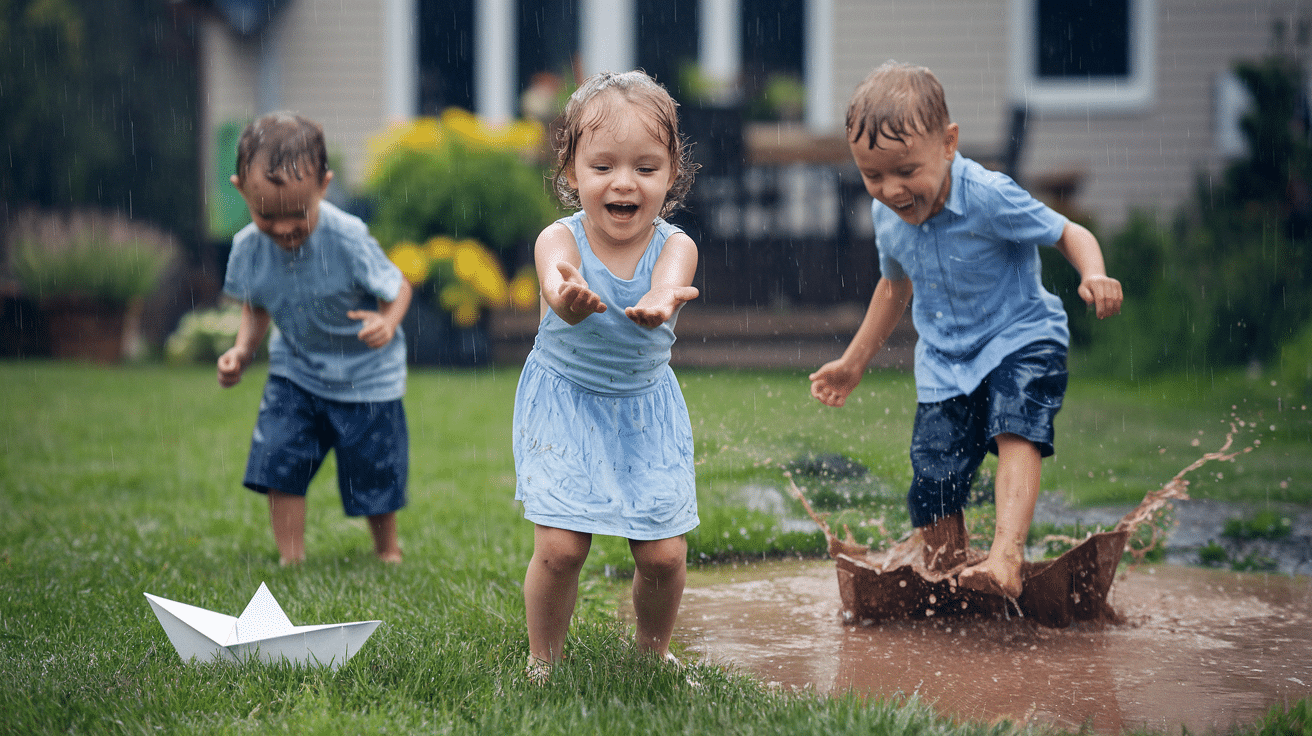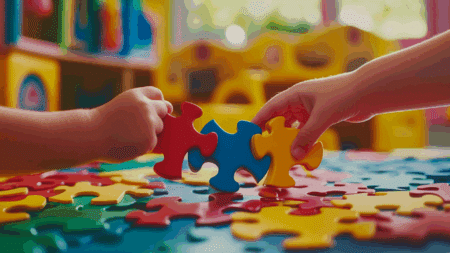Rainy days keep kids stuck indoors, making parents and teachers scramble for ways to keep little ones busy.
But what if rain could become a chance for fun and learning? Kids naturally want to splash in puddles and watch water drops race down windows.
Teachers and parents need simple, effective ideas that turn gloomy weather into happy moments. These rain activities for kindergarten kids mix play with learning, helping kids grow their skills while they have fun.
From water science experiments to craft projects with raindrops, these activities will keep kindergartners curious and engaged.
Let’s turn those rainy days into opportunities for growth and joy!
Exciting Outdoor Rain Activities for Kindergarten Kids

1. Raindrop Catching
Kids can experience the joy of catching raindrops with their hands or on umbrellas, improving hand-eye coordination and sensory awareness.
- Materials Needed: Umbrella, rain boots.
- How to Play: Give each child an umbrella and encourage them to try to catch raindrops as they fall, counting how many they can catch.
2. Mud Sculpting
Let kids get creative by making sculptures out of the mud, which allows them to express their artistic side while connecting with nature.
- Materials Needed: Mud, water, sticks, leaves
- How to Play: Show children how to mold the wet mud into sculptures like animals or shapes. Let them use sticks and leaves as tools or decorations.
3. Rainbow Exploration
Teach children about rainbows by looking for one in the sky after a rain shower, or create one artificially using a water hose.
- Materials Needed: A sunny day, water, hose (optional)
- How to Play: After the rain, guide children outside to look for a rainbow, or use a water hose and sunlight to create a mini rainbow for them to observe.
4. Rainwater Collection
Kids will learn about how rainwater is collected, and you can use it for science or gardening activities.
- Materials Needed: Buckets, containers
- How to Play: Set up containers outside to catch the rainwater. Afterward, let kids get the collected water, measure its volume, or use it for plant watering.
5. Rainy Day Nature Walk
Take the children on a nature walk to observe how the environment changes during and after a rainfall, helping them connect with the natural world.
- Materials Needed: Waterproof clothing, boots
- How to Play: Walk through puddles. Encourage children to notice the smells, sounds, and sights after a rainstorm.
6. Rainy Day Relay Races
A fun way to engage kids in physical activity, running through the rain or hopping over puddles as part of a relay race.
- Materials Needed: Cones, markers
- How to Play: Set up a simple relay course that kids can race through, hopping over puddles and running through the rain to get from one point to another.
7. Puddle Painting
Puddles can be used as a canvas for creating water-based art, teaching kids about colors, textures, and water movement.
- Materials Needed: Food coloring or washable paint, small containers
- How to Play: Let kids drop different colors into puddles and observe how the water moves, spreading the colors into fun designs.
8. Splash the Colors
Allow children to create colorful splashes in the rain by jumping in puddles with colored chalk or washable paint, mixing both fun and creativity.
- Materials Needed: Colored chalk, large plastic sheets or papers
- How to Play: Let kids jump into puddles with chalk in hand and leave colorful patterns as they splash around. Use the chalk to draw rain-themed designs afterward.
9. Raindrop Measurement
A fun science activity where kids measure how much rain falls during a storm and compare it to the height of different objects.
- Materials Needed: Measuring cups, rulers, clear containers
- How to Play: After it rains, help children measure how much rain has fallen in their containers. You can compare the amount with the height of toys or objects around them.
10. Rainy Day Obstacle Course
Set up an obstacle course that challenges kids to find puddles and slippery areas to turn a wet day into an experience.
- Materials Needed: Cones, sticks, rope
- How to Play: Design an obstacle course that involves jumping over puddles, crawling under ropes, or balancing along wet paths. Encourage the kids to complete the course in a race.
11. Nature Sound Scavenger Hunt
Teach kids to listen for the sounds of rain and wildlife after a storm, making it an auditory learning experience.
- Materials Needed: None
- How to Play: Send kids on a scavenger hunt to find sounds like raindrops on leaves, birds singing after the rain, or a flowing stream. You can use a checklist for them to mark each sound they hear.
12. Rainwater Footprint Tracking
This activity allows children to find out how their footprints make an impact on wet surfaces, learning about environmental impressions.
- Materials Needed: Water, mud or wet sand
- How to Play: Have children walk in muddy or wet areas and observe the tracks they leave behind. Discuss how footprints form and the nature of rain-soaked ground.
13. Dancing in the Rain
Let children embrace the joy of dancing in the rain, helping them release energy and enjoy the sensory experience of the weather.
- Materials Needed: Waterproof clothing
- How to Play: Encourage children to run, jump, and dance in the rain, enjoying the sensations of water and freedom while moving to their favorite tunes.
Cozy Indoor Fun: Rainy Day Activities for Kids

14. DIY Sensory Bins
Sensory bins offer kids a tactile experience, stimulating their senses as they dig through rice or beans to find hidden toys. It’s a fun, hands-on activity for kindergarten kids.
- Materials Needed: Rice, beans, small toys, containers
- How to Play: Fill containers with rice or beans and hide small toys inside for kids to find. Encourage them to use their hands or spoons to feel the textures.
15. Indoor Obstacle Course
Create a challenge by setting up an indoor obstacle course using pillows and cushions. Kids can crawl, jump through the course to improve agility and coordination.
- Materials Needed: Pillows, cushions, tape
- How to Play: Arrange pillows, chairs, and other items to create a course for kids to crawl under, jump over, and maneuver around. Time them to see how quickly they can complete it.
16. Balloon Volleyball
A fun indoor game that encourages teamwork and hand-eye coordination, kids hit a balloon back and forth while trying to keep it from touching the ground.
- Materials Needed: Balloon, space to play
- How to Play: Set up an area and use a balloon to play volleyball. Kids can hit the balloon back and forth, trying to keep it off the ground.
17. Coloring and Crafting
Let kids express their creativity with coloring and crafting projects. They can make their own artwork or follow templates for crafting animals, flowers, or other designs.
- Materials Needed: Crayons, markers, paper, glue, scissors
- How to Play: Give children paper and coloring supplies to make their own creations, or provide templates for crafts like making paper animals or flowers.
18. Puzzle Challenges
Puzzles help develop problem-solving skills as kids match pieces based on themes and difficulty levels, encouraging patience and cognitive growth.
- Materials Needed: Puzzles of varying difficulty.
- How to Play: Offer kids puzzles with different themes and difficulty levels. Encourage them to complete the puzzle by matching pieces and practicing patience.
19. Baking Cookies
Baking cookies together is an educational activity that teaches kids about measurements, mixing ingredients, and following instructions while having fun.
- Materials Needed: Baking ingredients, cookie cutters, baking sheet
- How to do it: Allow kids to help measure ingredients and mix them.
20. DIY Puppet Show
Encourage storytelling and creativity by helping kids make their own puppets from socks and craft supplies, then let them put on a puppet show for the family.
- Materials Needed: Socks, googly eyes, yarn, markers
- How to Play: Help kids create their own puppets using socks and craft materials. Then, they can put on a puppet show for the family.
21. Building with Blocks
Building with blocks enhances fine motor skills and spatial awareness as kids create towers, castles, and other structures, promoting imagination and creativity.
- Materials Needed: Building blocks (Lego, wooden blocks, etc.)
- How to Play: Challenge kids to build structures like castles, houses, or towers using building blocks. Encourage them to create different shapes and designs.
22. Science Experiments
Simple science experiments, like the baking soda and vinegar reaction, offer kids a fun way to learn scientific concepts through hands-on learning.
- Materials Needed: Baking soda, vinegar, food coloring, plastic containers
- How to Play: Demonstrate basic experiments like a baking soda and vinegar reaction, where kids can watch as the ingredients react to create a fizzy effect.
23. DIY Sensory Bottles
Sensory bottles help kids calm down by allowing them to feel textures and colors. Shake them up and watch glitter and objects swirl inside for a calming experience.
- Materials Needed: Clear bottles, glitter, water, food coloring, small objects
- How to Play: Fill clear bottles with water, glitter, and other small objects, sealing them tightly. Shake them up and watch the objects float and swirl inside.
24. Indoor Bowling
Set up a bowling alley with empty plastic bottles and a ball, encouraging kids to roll the ball and knock over the pins while keeping score.
- Materials Needed: Empty plastic bottles, a ball
- How to Play: Set up empty plastic bottles as bowling pins and use a ball to roll and knock them down. Keep score and encourage kids to improve their technique.
25. Interactive Storytime
Integrating actions or questions from the story can turn reading into an interactive experience, helping kids engage with the plot and enhancing their imagination.
- Materials Needed: Books with sound or interactive elements
- How to Play: Read a story aloud and incorporate interactive elements, like asking kids to act out parts of the story or answer questions about the plot.
26. Indoor Scavenger Hunt
Kids will love searching for hidden objects around the house based on a list, staying active while finding their environment in this fun scavenger hunt.
- Materials Needed: List of items to find (e.g., a red sock, a spoon, etc.)
- How to Play: Create a list of items for kids to find around the house. Set a time limit and see who can collect the most items.
27. Create a Mini Indoor Garden
Gardening indoors teaches kids about plant care. Let them plant seeds, water them, and watch the plants grow, fostering responsibility and a love for nature.
- Materials Needed: Small pots, soil, seeds, water
- How to Play: Let kids plant seeds in small pots and water them. Explain the process of growth and encourage kids to care for their plants.
28. Dance Freeze Game
The Dance Freeze game helps kids improve coordination and rhythm. They dance freely to music, and when it stops, they must freeze in place until the music starts again.
- Materials Needed: Music, open space
- How to Play: Play music and let kids dance freely. When the music stops, they must freeze in their current position.
Rain Activities for Kindergarten: Learn While Playing

29. Rain Cloud in a Jar
A fun science experiment where kids can learn about how clouds form and release rain, helping them understand basic weather concepts.
- Materials Needed: A jar, water, shaving cream, blue food coloring
- How to Play: Fill the jar with water, add shaving cream on top as a “cloud,” then slowly drip blue food coloring over the cloud. Watch as the “rain” falls into the jar, mimicking a real rainstorm.
30. Make a Simple Rain Gauge
Teach children about measuring rainfall with this simple activity that helps them understand how scientists track weather patterns.
- Materials Needed: A plastic bottle, ruler, scissors, tape
- How to Play: Cut the top off the bottle, then tape it upside down over the bottom half. Mark the sides with measurement lines, and place it outside to collect rain. Have children measure how much rain falls.
31. Raindrop Counting
A counting exercise that helps children practice numbers and counting while associating each number with a raindrop.
- Materials Needed: Paper, markers, small raindrop stickers or drawings
- How to Play: Draw a raincloud on a large sheet of paper and let children add a specific number of raindrops based on the number called out. It’s a fun way to practice counting.
32. Water Cycle in a Bag
An interactive way for kids to learn about the water cycle, demonstrating evaporation, condensation, and precipitation.
- Materials Needed: A plastic sandwich bag, water, tape, markers
- How to Play: Fill the bag with a small amount of water, tape it to a sunny window, and have children observe the condensation and evaporation process over the next few hours.
33. Puddle Reflection Art
A creative way to teach children about symmetry and reflections through puddle art.
- Materials Needed: Water, paper, markers or paint
- How to Play: Have children create simple drawings on paper, then place them in a shallow puddle. The water will create reflections, which kids can observe and discuss.
34. Rainy Day Weather Chart
Teach kids how to track weather patterns and observe changes in the environment over time.
- Materials Needed: Paper, markers, ruler
- How to Play: Create a weather chart and help children track the days it rains. Discuss how the weather affects the environment and why rain is essential for plants.
35. Measuring Rainfall with Cup Science
A hands-on activity that helps children understand the concept of measurement and comparison through rain collection.
- Materials Needed: Plastic cups, ruler, water
- How to Play: Place cups outside during a rainstorm to collect water. Afterward, have children measure the amount of rain collected and compare the results.
36. Rainy Day Shapes
Teach kids about basic shapes and geometry using raindrops and other rain-themed objects.
- Materials Needed: Paper, markers, cutouts of different shapes
- How to Play: Draw raindrops and other weather-related shapes, then have children match them to similar shapes from cutouts or objects around the room.
37. Rain Sound Identification
A listening activity where children practice focusing on and identifying different sounds associated with rain and weather.
- Materials Needed: A recording of rain sounds, a quiet space
- How to Play: Play recordings of various rain sounds and ask children to identify which sounds are rain, thunder, or wind. Discuss what causes each sound.
38. Rain-Themed Sensory Bin
A sensory activity that teaches kids about texture, measurement, and rain’s effects on the environment.
- Materials Needed: Plastic bin, rice or sand, toy animals, plastic plants, water
- How to Play: Fill a sensory bin with rice or sand, add water to simulate rain, and place toy animals and plants inside. Discuss how rain affects the environment and living creatures.
39. Raindrop Color Mixing
Teach kids about colors and mixing by using raindrops as a metaphor for blending primary colors to make new ones.
- Materials Needed: Water, food coloring (red, blue, yellow), small containers
- How to Play: Drop a few drops of different colored water into a bowl and mix them to see what new colors emerge. Let children experiment with mixing and discuss color theory.
Safety First: Must-Know Tips for Outdoor Play
When kids play outside in the rain, safety needs to come first. Children love puddles, but they need proper gear and watchful eyes to stay safe.
- Dress kids in waterproof boots and raincoats to keep them dry.
- Check the weather for lightning or strong winds, and stay inside if these occur.
- Set clear boundaries for where children can play.
- Remove slipping hazards from play areas before going outside.
- Keep a first aid kit nearby for small scrapes or falls.
Always make sure an adult keeps watch during outdoor rain play. Little ones may not notice dangers when they’re having fun splashing around. With these simple steps, rainy day outdoor activities can be both safe and enjoyable for everyone.
The Bottom Line
Rainy days provide the perfect opportunity for children to learn and play in new and exciting ways. The rain activities for kindergarten kids shared in this post help turn wet weather into fun moments for kindergartners.
These simple ideas blend learning with play, allowing kids to develop valuable skills while enjoying themselves.
Rain brings its magic to childhood. Through these water-based games and crafts, children can increase their thinking skills, stay active, and express their creativity.
Next time the rain falls, you can always turn to this list of rain activities for kindergarten to spark joy and imagination in their young and creative minds.
Which activity will you try first? Did your kids love any particular idea from this list? We’d love to hear about your experiences and any new activities you’ve created with your little ones.




